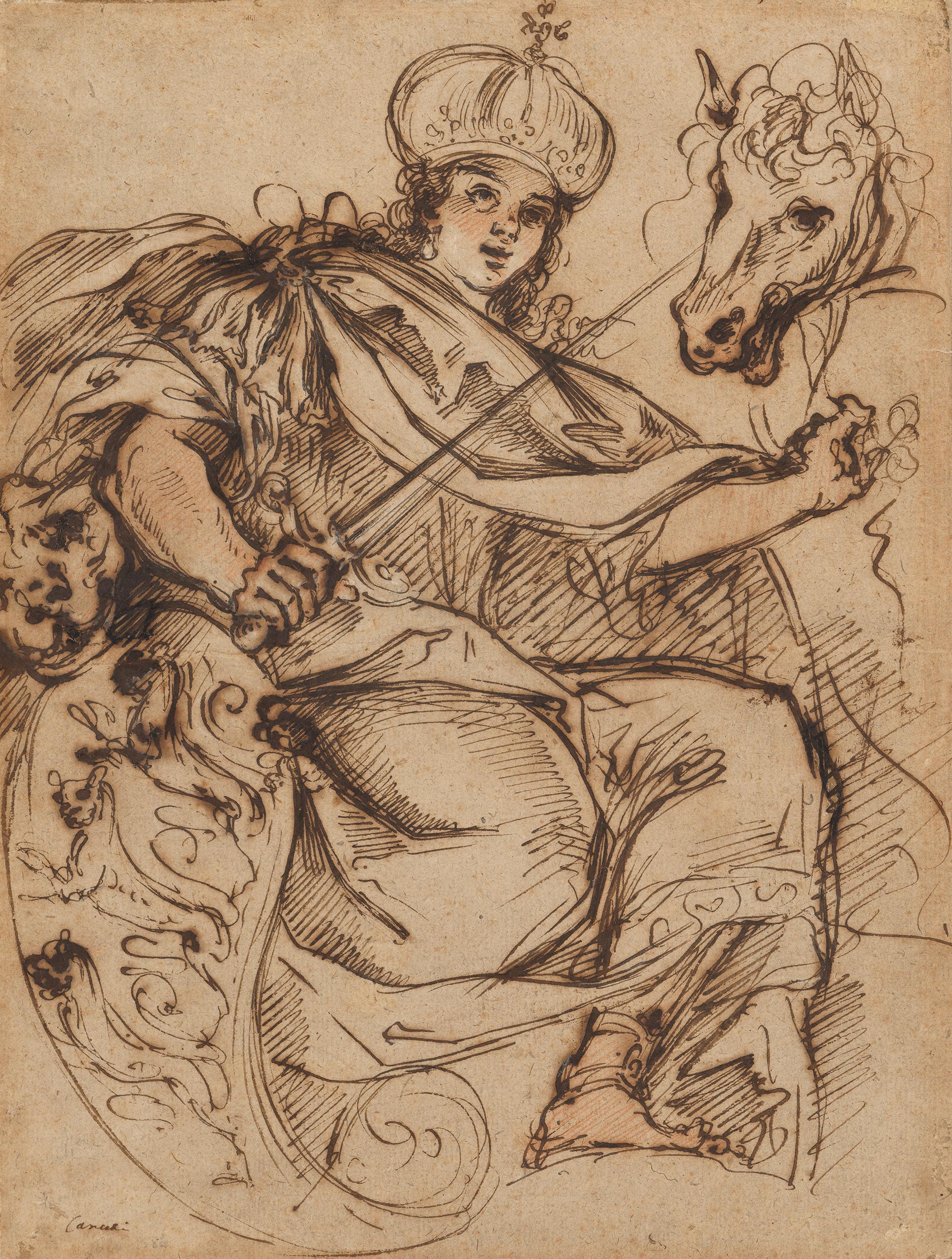
Rolli
Giuseppe Maria
Bologna 1645 — 1727
The Allegorical Figure of Scotland, holding a Sword and a Horse by its Reins, with a Shield adorned with Three Rampant Lions
Pen and dark brown ink, with heightening in red chalk and white heightening in the face. Bears inscription Canuti lower left.
384 x 296 mm (15 1/4 x 11 3/4 in.)
Bibliography
Ebria Feinblatt, “Some Drawings by Giuseppe Rolli identified”,
in Master Drawings, Vol. 20, no. 1 (Spring, 1982),
p. 25-28 and 76-85, pl. 34.
This exceptionally imposing and lively sheet is a preparatory study for one of the four corner medallions of the ceiling decorations surrounding The Apotheosis of the Marescotti family executed by Giuseppe Rolli in collaboration with his quadraturista brother Antonio Rolli on the ceiling of the ballroom of Palazzo Marescotti, Bologna, circa 1687-1709 (Fig. 1). Giampietro Zanotti, who mentions these sumptuous decorations, states that they earned him “a great honour.”1 The palazzo, modernised by its owner Raniere Marescotti, was decorated by the best Bolognese artists of the time: Domenico Maria Canuti, Marcantonio Franceschini and Rolli. Another related study is in the Uffizi, Florence, with an old attribution to Canuti, Rolli’s principal master (Inv. 4003 S).
The four medallions are personifications of the locations connected with the history of the family Marescotti. The medallion for which this drawing is preparatory represents Scotland, recalling the ancient origins of the family: in the 8th century, a Scottish warrior from Clan Douglas, known in Italy as Mario Scotto, presumably fought the Lombards alongside Charlemagne. Fervent Catholic and supporter of the Papacy, he allegedly participated in several military campaigns against the Saxons before getting married and settling in Italy. In 1707, with the Union Act, Scotland merged with England, whose three rampant lions are represented on the shield hold by the allegory, while the Scottish unicorn is suggested by the association between the horse’s head and the long sword evoking its horn. The family then spread to several Italian cities, including Bologna, Rome and Siena, which are identified in the other three medallions.
Giuseppe Maria Rolli, sometimes called Gioseffo Roli in ancient sources,2 was initially a pupil of Giovanni Battista Caccioti and then of Domenico Maria Canuti (1626-1684). The latter’s own training had been thoroughly Bolognese, under Albani, Reni and Guercino. Rolli and his brother established themselves with grand scale, illusionistic decorations in the churches of San Bartolomeo (1689), San Paolo Maggiore (1695-99) and San Giovanni dei Fiorentini (1699), as well as palaces of Marescotti Brazzetti, Casa Ranuzzi and Casa Mitiand Isolani. They also worked on other projects in Pisa as well as Germany, where they went in 1694 to decorate the castle of the Prince of Baden, according to Luigi Crespi3. Rolli is said to have ceased painting on gaining a large inheritance of a prosperous commerce. He was however forced to return to painting in his later years, albeit with less success4.
The outstanding graphic style of the present sheet which is both decorative and vigorous owes a lot to the manner of Canuti and demonstrates that Rolli’s draughtsmanship fits clearly into the Bolognese tradition.
- Giampietro Zanotti, Storia dell’Accademia Clementina di Bologna, vol. 1, Bologne, 1739, p. 408.
- Pellegrino Antoni Orlandi, Abecedario pittorico, Naples 1763, p. 202; Zanotti, op. cit., p. 405-414.
- Luigi Crespi, Vite de’ pittori bolognesi non descrite nella Felsina Pittrice alla maesta di Carlo Emanuele III re di Sardegna, Rome, Pagliarini, 1764, p. 124.
- Zanotti, op. cit., p. 413.

